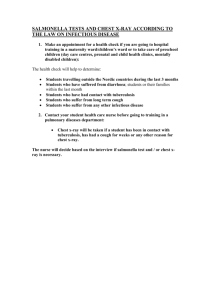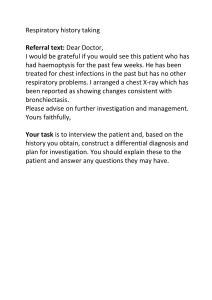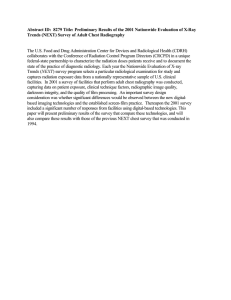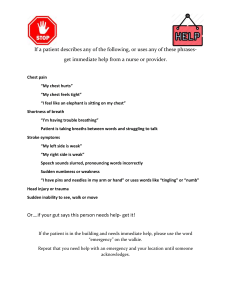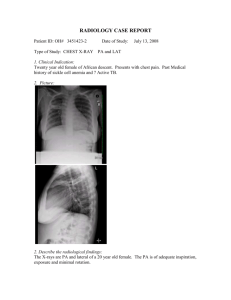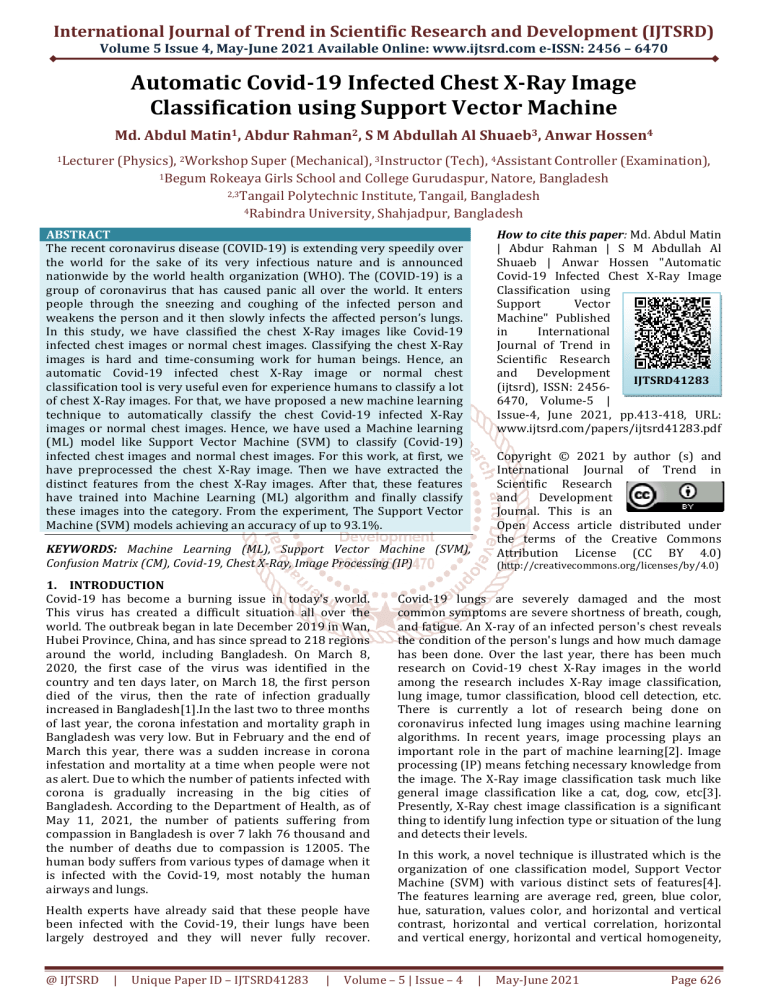
International Journal of Trend in Scientific Research and Development (IJTSRD)
Volume 5 Issue 4, May-June 2021 Available Online: www.ijtsrd.com e-ISSN:
ISSN: 2456 – 6470
Automaticc Covid-19
Covid
Infected Chest X-Ray
Ray Image
Classification using
sing Support Vector Machine
Md. Abdul Matin1, Abdur Rahman2, S M Abdullah Al Shuaeb3, Anwar Hossen4
1Lecturer
(Physics), 2Workshop Super (Mechanical), 3Instructor (Tech), 4Assistant Controller (Examination),
1Begum Rokeaya Girls School and College Gurudaspur, Natore, Bangladesh
2,3Tangail Polytechnic
Polytechn Institute, Tangail, Bangladesh
4Rabindra University, Shahjadpur, Bangladesh
How to cite this paper:
paper Md. Abdul Matin
| Abdur Rahman | S M Abdullah Al
Shuaeb | Anwar Hossen "Automatic
Covid-19
19 Infected Chest X-Ray
X
Image
Classification using
Support
Vector
Machine" Published
in
International
Journal of Trend in
Scientific Research
and Development
IJTSRD41283
(ijtsrd), ISSN: 24562456
6470, Volume-5
Volume
|
Issue-4,
4, June 2021, pp.413-418,
pp.413
URL:
www.ijtsrd.com/papers/ijtsrd41283.pdf
ABSTRACT
The recent coronavirus disease (COVID-19)
19) is extending very speedily over
the world for the sake of its very infectious nature and is announced
nationwide by the world health organization (WHO). The (COVID-19) is a
group of coronavirus that has caused panic
pani all over the world. It enters
people through the sneezing and coughing of the infected person and
weakens the person and it then slowly infects the affected person’s lungs.
In this study, we have classified the chest X-Ray
X
images like Covid-19
infected chest
hest images or normal chest images. Classifying the chest X-Ray
X
images is hard and time-consuming
consuming work for human beings. Hence, an
automatic Covid-19
19 infected chest X-Ray
X
image or normal chest
classification tool is very useful even for experience humans to
t classify a lot
of chest X-Ray
Ray images. For that, we have proposed a new machine learning
technique to automatically classify the chest Covid-19
Covid
infected X-Ray
images or normal chest images. Hence, we have used a Machine learning
(ML) model like Support Vector
ctor Machine (SVM) to classify (Covid-19)
infected chest images and normal chest images. For this work, at first, we
have preprocessed the chest X-Ray
Ray image. Then we have extracted the
distinct features from the chest X-Ray
Ray images. After that, these features
featur
have trained into Machine Learning (ML)
ML) algorithm and finally classify
these images into the category. From the experiment, The Support Vector
Machine (SVM)
SVM) models achieving an accuracy of up to 93.1%.
Copyright © 2021
20
by author (s) and
International Journal of Trend in
Scientific Research
and
Development
Journal. This is an
Open Access article distributed under
the terms of the Creative Commons
Attribution License (CC BY 4.0)
KEYWORDS: Machine Learning (ML),
ML), Support Vector Machine (SVM),
Confusion Matrix (CM), Covid-19, Chest X-Ray,
Ray, Image Processing (IP)
1. INTRODUCTION
Covid-19
19 has become a burning issue in today's world.
This virus has created a difficult situation all over the
world. The outbreak began in late December 2019 in Wan,
Hubei Province, China, and has since spread to 218 regions
around the world, including Bangladesh. On March 8,
2020, the first case of the virus was identified in the
country and ten days later, on March 18, the first person
died of the virus, then the rate of infection gradually
increased in Bangladesh[1].In
.In the last two to three months
off last year, the corona infestation and mortality graph in
Bangladesh was very low. But in February and the end of
March this year, there was a sudden increase in corona
infestation and mortality at a time when people were not
as alert. Due to which the number
mber of patients infected with
corona is gradually increasing in the big cities of
Bangladesh. According to the Department of Health, as of
May 11, 2021, the number of patients suffering from
compassion in Bangladesh is over 7 lakh 76 thousand and
the number
er of deaths due to compassion is 12005. The
human body suffers from various types of damage when it
is infected with the Covid-19,
19, most notably the human
airways and lungs.
Health experts have already said that these people have
been infected with the Covid-19,
19, their lungs have been
largely destroyed and they will never fully recover.
@ IJTSRD
|
Unique Paper ID – IJTSRD41283
41283
|
(http://creativecommons.org/licenses/by/4.0
http://creativecommons.org/licenses/by/4.0)
Covid-19
19 lungs are severely damaged and the most
common symptoms are severe shortness of breath, cough,
and fatigue. An X-ray
ray of an infected person's chest reveals
the condition of the person's lungs and how much damage
has been done. Over the last year, there has been much
research on Covid-19
19 chest X-Ray
X
images in the world
among the research
ch includes X-Ray
X
image classification,
lung image, tumor classification, blood cell detection, etc.
There is currently a lot of research being done on
coronavirus infected lung images using machine learning
algorithms. In recent years, image processing plays
pl
an
important role in the part of machine learning[2].
learning
Image
processing (IP) meanss fetching necessary knowledge from
the image. The X-Ray
Ray image classification task much like
general image classification like a cat, dog, cow, etc[3].
etc
Presently, X-Ray
Ray chest image classification is a significant
thing to identify lung infection type or situation of the lung
and detects their levels.
In this work, a novel technique is illustrated
i
which is the
organization of one classification model, Support Vector
Machine (SVM)
SVM) with various distinct sets of features[4].
features
The features learning are average red, green, blue color,
hue,
ue, saturation, values color, and horizontal and vertical
contrast, horizontal and vertical correlation, horizontal
and vertical energy, horizontal and vertical homogeneity,
Volume – 5 | Issue – 4
|
May-June 2021
202
Page 626
International Journal of Trend in Scientific Research and Development (IJTSRD) @ www.ijtsrd.com eISSN: 2456-6470
gray-level co-occurrence matrix (GLCM),
GLCM), and compost
automatic various features for SVM algorithm and their
convention. These features have complied to learn the
machine learning (ML)
ML) models for classifying the X-Ray
X
chest image.
In our research work, our image dataset contained 140 XX
Ray images that are categorized into two classes of chests
namely normal chest and covid-19
19 infected chest images.
From the experimental result, we have investigated that
the SVM algorithm classifies the normal chest image and
Covid-19
19 chest image. From our observation, the Support
Vector Machine (SVM)
SVM) model illustrates the accuracy is
(93.9%).
The rest of this paper is as follows. Section 2 describes the
literature review. Section 3 represents the dataset and
methodology. Section 4 depicts the results Section 5
displays the conclusion.
2. Literature Review
Saurabh Kumar et al. in [5] tried to classify chest X-Ray
X
images using deep learning. They have scaled all the
images of the data set to a uniform size of 512×512. Here
they have used 401 images for these classification
problems. This dataset contains 401 images out of which
262 images are covid-19
19 negative and the rest of these
images are covid-19
19 positive and they have achieved a
high accuracy result. For a good result, the deep learning
model required huge image data but they have used
us only
401 images sample for this classification problem. So it
was the limitation of their research work.
The authors in [6] described medical imaging such as XX
ray and Computed Tomography (CT)
CT) associated with the
potential of Artificial Intelligence (AI)
AI) plays a vital role in
siding
ing the medical staff in the diagnosis process. These
types of image classification they have used five deep
learning algorithm namely (ResNet18,
ResNet18, ResNet34,
InceptionV3, InceptionResNetV2, and DenseNet161). In
this study, they used two public datasets and the
t
first
dataset was the COVID-19
19 image data collection,
consisting of 236 images of COVID-19,
19, 12 images of
COVID-19
19 and ARDS, 4 images of ARDS, 1 image of
Chlamydophila, 1 image of Klebsiella, 2 images of
Legionella, 12 images of Pneumocystis, 16 images of
o SARS,
13 images of Streptococcus and 5 images without any
pathological findings and the second dataset was covid-19
covid
X-Ray
Ray images. Here, they have used a deep learning model
for classifying the covid-19
19 positive or negative case. The
performance of the Deep
ep Learning Algorithm depends on
its data set which means the amount of data needed for
good results but here they have used very few images for
their work so the algorithm may provide bias results.
Shelke et al. in [7]were
were described the classification model
to classify the X-Ray
Ray image. Here, they have used four
classes of X-Ray
Ray images namely normal, pneumonia,
tuberculosis (TB),
TB), and COVID-19.
COVID
They have used a deep
learning model used for the classification of pneumonia,
TB, and normall is VGG16 with an accuracy of 95.9 %. But
they don't explain how many images they've used for their
research that is the drawback of their work.
Another CXR image classification task was described
here[8].. Here, the authors have used
u
the deep Residual
Network (RESNET-50).
50). In this classification, they have
used four types of CXR image cases like healthy
individuals, bacterial and viral pneumonia, and COVID-19
COVID
positives patients. The model performance metrics
showed an accuracy of 99%.
%. But a large amount of data
are required for the deep learning algorithm for high
accuracy but a small number of images were used for
these purposes which is the limitation of their research.
The authors in [9] were described
escribed the rapid development
in the area of Machine Learning (ML) and Deep Learning.
Here, they have proposed intelligent systems to classify
between Pneumonia and Normal patients. The proposes of
the machine learning-based
based classification of the extracted
extracte
deep feature using ResNet152 with COVID-19
COVID
and
Pneumonia patients on chest X-ray
X
images. SMOTE was
used for balancing the imbalanced data points of COVIDCOVID
19 and Normal patients. The model has achieved accuracy
up to .97% on Random Forest and 97.4%n using XGBoost
predictive classifiers.
3. Methodology and Dataset
In this part, the algorithm and datasets are described. The
algorithm is used to classify covid-19
covid
infected and normal
chest X-Ray
Ray images. The algorithm includes SVM (Support
Vector Machine). The chest
st X-Ray
X
images of two levels of
normal and covid-19
19 are provided as the dataset in the
algorithm.
3.1. Proposed System
The proposed system block diagram is shown here. The
block diagram is shown in Fig.3.1. The training images are
resized, and many pre-processing
processing are executed. So that the
original images may carry many noise and errors. Then
the contrast of the images is increased. Many features are
extracted and then the machine learning model is applied
to classify the images. When the training
tr
is finished, the
accuracy of the model is calculated using the test images
and confusion matrix.
Fig. 3.1: Proposed System Block Diagram
@ IJTSRD
|
Unique Paper ID – IJTSRD41283
41283
|
Volume – 5 | Issue – 4
|
May-June 2021
202
Page 627
International Journal of Trend in Scientific Research and Development (IJTSRD) @ www.ijtsrd.com eISSN: 2456-6470
The algorithm of the proposed system is illustrated in Algorithm 1. This algorithm represents the steps of the proposed
model.
Algorithm 1: Covid-19 chest X-Ray image classification
1 Read training images from the dataset
2 Pre-process images
3 Train the model SVM to classify
4 Read test image
5 Apply the trained model to classify the test image
6 Control the classification_error
7 If (False_result> threshold)
Jump to step 1.
Else
achieve accuracy.
3.2. Dataset Description
In this work, we have collected many chest X-Ray images from different Medical colleges and private Hospitalsof the
Mymensingh and Tangail districts in Bangladesh.
Fig 3.2: Two levels Chest X-Ray Images
These chest X-Ray images having two levels were taken from different Medical colleges and private Hospitals of the
Mymensingh and Tangail, Dhaka, Natore districts in Bangladesh. The chest X-Ray images are then categorized into two
classes based on two levels of covid-19 infected and normal chest depicted in the figure. 3.2. Each class has more than
seventy images. Details of each class are shown in Table 3.1. These images are divided randomly into training (70%) and
testing (30%) images.
Table 3.1: Details of Image Dataset
Class Name
Label No. of image
Covid-19 Infected image
0
75
Normal images
1
79
Total Images
154
3.3. Image Pre-processing
Training images are collected from different places may be of various resolution and with noise. Therefore, image preprocessing is needed for reshaping the images and avoiding the noise. We have used Matlabresize () function to resize the
pictures to 350*180 pixels, filter () function for smoothing, sharpening. Here, we have also used the gray2rgb () function
for eliminating the hue and saturation information, gray_comatrix () function for using texture analysis of the images.
Tab 3.2: Image Preprocessing Function
ML Model
SVM
Description
Use the Matlab Functions
Resize to 350 x 180 pixels
resize ()
Filtering for smoothing, sharpening
The gray2rgb function for eliminating the hue and
saturation information of the images.
Graycomatrix function for texture analysis of the images.
filter ()
rgb2gray ()
graycomatrix ()
3.4. Feature Extraction
Feature learning is the next processing step in image analysis. It can be used for images. Feature extraction is the
measurable character of an image or object.
@ IJTSRD
|
Unique Paper ID – IJTSRD41283
|
Volume – 5 | Issue – 4
|
May-June 2021
Page 628
International Journal of Trend in Scientific Research and Development (IJTSRD) @ www.ijtsrd.com eISSN: 2456-6470
Tab 3.3: Feature Extraction Function of machine learning model
ML
Model
Feature Name
Average red color
Average green color
Average blue color
Average hue color
SVM
Average saturation color
Average values color
Horizontal and Vertical Contrast
Horizontal and Vertical Correlation
Description
The average value of all red pixels in the chest
X-Ray image surface
The average value of all green pixels in the chest
X-Ray image surface
The average value of all blue pixels in the chest
X-Ray image surface
The average value of all hue pixels in HSV the
chest X-Ray image surface
The average value of all saturation pixels in HSV
the chest X-Ray image surface
The average value of all values pixels in HSV
chest X-Ray image surface
Find the local variation of the gray-level
level coco
occurrence matrix
Find the joint probability occurrence of the
specified pixel pairs.
Matlab
Functions
Rave=uint8
(mean ())
Gave=uint8
(mean ())
Bave=uint8
(mean ())
Have=uint8
(mean ())
Save=uint8
(mean ())
Save=uint8
(mean ())
Contrast ()
Correlation ()
3.5. Chest X-Ray
Ray Image Classification or prediction
It classifies the target chest X-Ray
Ray class into a predefined input image using a machine learning algorithm. After the
finishing of the feature extraction process, the images are first trained through the machine learning SVM (Support Vector
Machine) model, and when the finishes the training process, we have examined with a single image that is not training by
the trained classifier. The testing classifier compares the new testing image with previously trained different image levels.
When the testing image is equalized the levels train images the machine learning model classifies the target chest X-Ray
image levels.
3.6. Machine Learning Models
Machine learning (ML)
ML) is the data analytical design that instructs computers to do what comes naturally to human study
from knowledge. Machine learning (ML)
ML) models use the computational process to learn facts immediately from data
without depending on a predetermined equation as an algorithm[10].The
algorithm
.The models adaptively progress their achievement
as the number of samples gain able for studying increases.
increases In this work, we have to study Support Vector Machine (SVM)
machine learning algorithms to complete the automatic covid-19
covid
infected chest image classification
lassification work.
3.7. Support Vector Machine (SVM)
SVM) Model
Support vector machine is a supervised Machine Learning (ML)
ML) algorithm. It can be used for both classification and
regression problems[11].. But it is popularly used for classification.
classification. The primary goal of the Support Vector Machine (SVM)
is to find the hyper plane which divides the two classes of data.
Fig.3.3: Internal Structure of Support Vector Machine (SVM)
SVM)
In most cases, a support vector machine is used to classify the data. A hyper plane which partitions two class with
maximum distance is called an optimal hyper plane.
plane SVM is very skillful for the supervised classifier. In this work, the
Support Vector Machine (SVM)
SVM) algorithm is used for two types of chest X-Ray
X
image
age classification shown in (Fig.3.3). An
SVM model is a representation of the examples as points in the coordinate system, mapped so that the sample of the two
classes are divided by a clear gap that is as wide as possible. Given a training set of two classes,
classes, G = { (xi, Yi), i = 1 … N} with
a hyperplane
0, xi ϵ Rn and y ϵ {1, −1}, the support vector machine satisWies the following conditions:
Or equivalently,
1,
1,
1,
@ IJTSRD
|
1,
(3.5)
(3.6)
1,
1,2,3,.. … … N
Unique Paper ID – IJTSRD41283
41283
(3.7)
|
Volume – 5 | Issue – 4
|
May-June 2021
202
Page 629
International Journal of Trend in Scientific Research and Development (IJTSRD) @ www.ijtsrd.com eISSN: 2456-6470
Where is the function that maps training vector xi to the higher dimensional space when the data points are linearly
separable. The distance from a point xi to the hyper plane is:
(3.8)
|| ||
From the definition of SVM, the margin is ‖
#
‖
"
. Hence, the equation of hyper plane is ���� (�) = || ||#
#
(3.9)
According to the saddle point of the Lagrange function, the solution of the above equation is,
"
||$||# ∑()" & ' $
14
(3.10)
!"
#
where �� are the nonnegative Lang range multipliers. When the data is not separable, a new slack variable �� is
introduced and the optimization equation is
1 *
(3.11)
"
And the hyper plane equation is- ���� (�
�, �) = ||$||# 5 ∑()" *
(3.12)
#
where C is a positive constant parameter used as a penalty parameter for the error term. If the optimization of the support
vector machine uses linear and radial basis function, then
th the equation is: + ,
6
+
,
, -, - . /0|
#
|0 1 , / 2 0
(3.13)
Where γ is the kernel parameter. Figure. 3.3 represents the visualization of SVM. The main advantage of the support vector
machine is that it is effective in high dimensional spaces and it also works well with a clear margin of separation. The
primary drawback of the support vector machine is that it does not well perform when the data set is large. The support
vector machine also low performance, the data set, is rowdy.
4. Result Analysis
In this part, we have discussed the classification performance of the support vector machine for these two classes chest XRay image prediction task. The Confusion
onfusion Matrix (CM) is a table that mostly behaves to consider the achievement of a
classification model on a set of testing data for which the true values are acquainted[12].
acquainted
. The Confusion Matrix (CM) itself
is comparatively easy to realize for that many researchers use it.
Fig. 4.1: Confusion Matrix of Support Vector Machine
In (Fig.4.1)
Fig.4.1) we see that diagonally shaded boxes display the percent accuracy result of the SVM model. On the other side
shaded box illustrated the percent of mistakes for the classification problem. The average accuracy of the support vector
machine classifier is depicted for the classification problem is 93.1% that means the average achievement accuracy for the
overall classifier with the best value is (93.1%).
93.1%). In common mistake for the overall classifier with the value is (6.9%). In
this study, we see that’s the covid-19_infected_chesthas
19_infected_chesthas displayed the highest and theNormal_chest illustrated the lowest
classification accuracy respectively.
5. Conclusion
In the study, we have proposed a novel technic to classify
Chest X-Ray images with two-level
level using the Machine
Learning (ML) model.. The raised system is used machine
learning models to automatically classify the Covid-19
Cov
infected chest X-Ray
Ray image and Normal chest X-Ray
X
image.
Our proposed system includes three phases: Image prepre
processing features learning or extraction, and
@ IJTSRD
|
Unique Paper ID – IJTSRD41283
41283
|
classification. Image Pre-processing
processing means resizing the
image, noise avoiding. Then, we have extracted distinct
features like RGB color, HSV color, horizontal and vertical
contrast, etc are extracted. In fine, the classification part
can be performed after the feature vectors are propagated
for every image. The Support vector machine (SVM)
classifier is used for the classification problem. Our
proposed system has been performed evaluated using
Volume – 5 | Issue – 4
|
May-June 2021
202
Page 630
International Journal of Trend in Scientific Research and Development (IJTSRD) @ www.ijtsrd.com eISSN: 2456-6470
154Chest X-Ray images. From among these images, we
have used 70 % images for training and 30% images for
testing randomly. From the experimental result, we have
achieved accuracy up to 93.1%.
[5]
S. Kumar, S. Mishra, and S. K. Singh, “Deep transfer
learning-based COVID-19 prediction using chest Xrays,” medRxiv, no. September 2003, 2020, doi:
10.1101/2020.05.12.20099937.
ACKNOWLEDGMENT
The authors wish to thank BegumRokeayaGirlsSchool and
college Gurudaspur, Natore, Bangladesh. The authors also
thank its research lab for their helpful guidance and useful
supports.
[6]
S. Chatterjee et al., “Exploration of Interpretability
Techniques for Deep Covid-19 Classification Using
Chest X-Ray Images,” arXiv, 2020.
[7]
A. Shelke et al., “Chest X-ray classification using
Deep learning for automated COVID-19 screening,”
medRxiv, no. December 2019, 2020, doi:
10.1101/2020.06.21.20136598.
[8]
Z. Tang et al., “Severity assessment of coronavirus
disease 2019 (COVID-19) Using quantitative
features from chest CT images,” arXiv, vol. 2019, pp.
1–18, 2020.
[9]
R. Kumar et al., “Accurate Prediction of COVID-19
using Chest X-Ray Images through Deep Feature
Learning model with SMOTE and Machine Learning
Classifiers,” medRxiv, pp. 1–10, 2020, doi:
10.1101/2020.04.13.20063461.
[10]
Y. Baştanlar and M. Özuysal, “Introduction to
machine learning,” Methods Mol. Biol., vol. 1107, pp.
105–128, 2014, doi: 10.1007/978-1-62703-7488_7.
[11]
H. Bhavsar and M. H. Panchal, “A Review on Support
Vector Machine for Data Classification,” Int. J. Adv.
Res. Comput. Eng. Technol., vol. 1, no. 10, pp. 2278–
1323, 2012.
[12]
D. Houcque, “Introduction To Matlab
Engineering Students,” no. August, 2005.
COMPETING INTERESTS
The authors have declared that no competing interests
exist.
References
[1] S M Abdullah Al Shuaeb | Md. Kamruzaman |
Mohammad Al-Amin, “COVID 19 Outbreak
Prediction and Forecasting in Bangladesh using
Machine Learning Algorithm,” Int. J. Trend Sci. Res.
Dev., vol. 5, no. 1, pp. 829–835, 2020.
[2]
[3]
[4]
A. V Galphade and K. H. Walse, “Supervised
Learning Approach for Flower Images using Color ,
Shape and Texture Features,” Int. Res. J. Eng.
Technol., vol. 6, no. 5, pp. 5682–5688, 2019.
C. Chen, Q. Yan, M. Li, and J. Tong, “Classification of
blurred flowers using convolutional neural
networks,” ACM Int. Conf. Proceeding Ser., pp. 71–74,
2019, doi: 10.1145/3342999.3343006.
I. Patel and S. Patel, “Flower identification and
classification using computer vision and machine
learning techniques,” Int. J. Eng. Adv. Technol., vol. 8,
no.
6,
pp.
277–285,
2019,
doi:
10.35940/ijeat.E7555.088619.
@ IJTSRD
|
Unique Paper ID – IJTSRD41283
|
Volume – 5 | Issue – 4
|
May-June 2021
for
Page 631
International Journal of Trend in Scientific Research and Development (IJTSRD) @ www.ijtsrd.com eISSN: 2456-6470
Authors Profiles
SN
Name and Designation
01
Md. Abdul Matin
Lecturer of Physics
Begum Rokeaya Girls School and
College Gurudaspur, Natore,
Bangladesh Under the Ministry of
Education, Bangladesh.
Email: fakirmatinphysics@gmail.com
02
Qualification and Experiences
Photo
I am a Lecturer of Physics Department at Begum Rokeaya
Girls School and College Gurudaspur, Natore, Bangladesh
Under the Ministry of Education, Bangladesh. I have been in
a great profession like teaching for about 9 years. I got my
bachelor's
degree
from
Rajshahi
University
(RU)Bangladesh. Even though I studied physics, but, I have
a lot of interest in applied Physics and Electronics,
computer engineering, especially machine learning, image
processing, etc. I want to take my research program a long
way
Engr. Abdur Rahman
I am a teacher of the Mechanical Department at Tangail
Polytechnic Institute, Tangail, Bangladesh. I have been in a
Workshop Superintendent
great profession like teaching for about 9 years. I got my
bachelor's
degree from Dhaka University of Engineering and
(Mechanical)
Technology (DUET), Bangladesh. Although I am a mechanical
Tangail Polytechnic Institute, Tangail. engineer, I have a lot of interest in computer engineering,
especially machine learning, image processing, etc. I want to
Directorate of Technical Education,
take my research program a long way.
Under Technical and Madrasha
Education. Division of Ministry of
Education, Bangladesh.
Email: rahman9332@gmail.com
03
Email: nixon.cse28@gmail.com
I am an Instructor (Tech), Computer Technology, Tangail
Polytechnic Institute, Tangail, Bangladesh. I have 8 years of
experience in teaching. I received my B.Sc. Engineering
degree in CSE from the University of Jatiya Kabi Kazi Nazrul
Islam University(JKKNIU), Trishal, Mymensingh, and MS in
CS from Bangladesh Agriculture University(BAU),
Bangladesh respectively. My area of interest for research are
Machine Learning, Computer Vision, Image Processing,
Digital Signal Processing, and Bioinformatics. For the last
three years, I am accelerating my research journey in the
area of machine learning.
Anwar Hossen
I am Assistant Controller of Examinations
Assistant Controller of Examinations
Rabindra University, Shahjadpur, Sirajganj, Bangladesh. I
have 5 years of experience in controller examination. I
received my B.Sc. Engineering degree in CSE from the
University of Jatiya Kabi Kazi Nazrul Islam University,
Trishal, Mymensingh,. My area of interest for research are
Machine Learning, Computer Vision, Image Processing,
Digital Signal Processing, and Bioinformatics. For the last
three years, I am accelerating my research journey in the
area of machine learning.
S M Abdullah Al Shuaeb
Instructor(Tech),
Technology,
Computer
Tangail Polytechnic Institute, Tangail.
Directorate of Technical Education,
Under Technical and Madrasha
Education Division of Ministry of
Education, Bangladesh.
04
Rabindra University, Bangladesh
Shahjadpur, Sirajganj, Bangladesh
Email: suhag.cse@gmail.com
@ IJTSRD
|
Unique Paper ID – IJTSRD41283
|
Volume – 5 | Issue – 4
|
May-June 2021
Page 632

